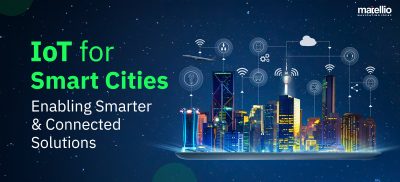
A solar energy monitoring system offers real-time tracking and recording, which improves the efficiency of solar systems and gives a high rate of return.
Do you own the business of solar power plant and perhaps facing issues in managing the same? Well, we have a solution for you!
Electricity is getting more expensive every day. Consumers are worried about their rising energy bills due to their increase in energy usage and conventional grid dependency.
This is why switching to solar energy has become a well-known and dependable solution with so many financial advantages over a period of time. Around 70,000 solar panels are expected to be added every hour globally in the next five years, as per the stats.
The world is moving towards a sustainable future, and renewable energy sources like solar power are becoming increasingly popular with time. And, with the rise of solar power installations, it has become essential to monitor and manage them efficiently to make sure they’re operating at maximum efficiency so you can benefit from solar for a long time.
But how to approach monitoring? A choice you’ll have to make to perfectly utilize your solar power system. Any system’s monitoring is a crucial part that affects both its cost and effectiveness as a whole. This is where IoT (Internet of Things) comes into play.
By using IoT-based solar power monitoring systems, you can gather and analyze data to optimize solar energy usage and improve the performance of solar installations. Let’s see how?
What is IoT?
IoT, or you can say “The Internet of Things,” is defined as the network of physical devices, vehicles, appliances, and other objects embedded with sensors, software, and network connectivity through which you can collect and exchange data. From simple sensors that detect changes in temperature or humidity to complex systems like self-driving cars and smart homes, IoT is everywhere.
It enables the devices to communicate and interact with each other and with humans, creating an interconnected world where data can be shared and analyzed in real time.
The Internet of Things has been embraced by various sectors all across the world over the last 20 years. Instead of being restricted to early adopters, it has substantially matured and evolved into mainstream technology. There are no signs that innovation in this technology will slow down anytime soon.
What is a Solar Power Monitoring System?
The term defines itself!
A solar power monitoring system is a digital solution designed to monitor the performance of a solar power installation. It helps to gather useful data via sensors that are installed on various components of the solar power system, such as solar panels, inverters, and batteries. Further with which, you can analyze and determine the performance and efficiency of your solar power system and also identify any issues that may be affecting its efficiency or output.
The data includes information on the amount of energy generated by the solar panels, the temperature of the solar panels, the voltage and current output of the solar panels, the state of charge of the batteries, and the efficiency of the inverters.
By monitoring the system’s performance, you can identify issues early on and take corrective measures before they become bigger problems that can impact the system’s energy output and reliability.
Why IoT in Solar Power Monitoring Systems?
The Internet of Things (IoT) is an interesting concept touching practically every area of our modern life. Countless industries, from service providers and retailers to manufacturers and distributors of hardware, are beginning to investigate the potential of utilizing the Internet of Things.
The solar industry is one such sector!
Things have changed significantly since the early 1990s when solar panels were large and unsightly to most consumers. Today, the Internet of Things (IoT) has made it possible to even create portable solar cells that can be mounted on cars and on rooftops. With time, the Internet of Things (IoT) is developing as a cutting-edge technology that uses a cloud platform and protocol stack to make things quite intuitive and user-friendly.
The performance and monitoring of the plant can be considerably improved by using IoT to oversee solar energy. It monitors the dust that has accumulated on the solar panels to generate the most power possible for active utilization. The photovoltaic (PV) system gathers, monitors, and exchanges data with the help of advanced IoT devices that are equipped with software, network connectivity, and sensors.
IoT-based solar power monitoring system is intended for online performance improvement and simulation. It enables preventive maintenance, identifying the accident’s root cause, and pinpointing the breakdown’s location.
Also, with an IoT-based monitoring system, you can get insights into the energy usage patterns of your power system, which helps you identify opportunities to lessen energy consumption and save money on energy bills.
By leveraging the power of IoT, you can manage your solar energy resources more efficiently. Further, allowing you to make better decisions based on facts. By using IoT-generated data, you can also determine and look into user power usage trends.
If you are looking for an IoT-based monitoring system for your solar business, we are here to help you provide top-notch IoT development services.
Benefits of Using an IoT-based Solar Power Monitoring System
It doesn’t matter what you are monitoring; it always comes out as a must-do thing to better track performance and work on it accordingly. Especially when it comes to solar plants, monitoring is a MUST! There are several compelling reasons to use IoT-based solar power monitoring systems that can further benefit your business in one way or the other. Let’s go through some of them:
Improved Performance
Obviously, the better you monitor the functions of your power system, the better you will work on the voids and make it perform as efficiently. By gathering and analyzing data from sensors installed in the solar power system, an IoT-based monitoring system can identify and fix issues that could be impacting the performance of the solar panels. This can lead to improved performance, increasing the energy output.
Read More: How to Develop Solar Asset Management Software?
Remote Monitoring and Control
Even if your plant is far away from your location, you can always remote monitor and control your solar power system, troubleshoot issues, and perform maintenance tasks without actually having any physical access to the system.
Cost-effectiveness
An IoT-based monitoring system identifies issues before they become critical, which reduces the cost of maintenance and repairs, if any. Also, by optimizing the performance of the solar power system, an IoT-based system can lead to cost savings by reducing the demand for additional energy sources and leading to an increase in the lifespan of solar power installation.
Energy Optimization
You can analyze the data of your solar power system with the help of an IoT-based monitoring system and optimize the use of solar energy by adjusting the power output based on current conditions. This can lead to increased energy efficiency and cost savings.
All in all, you must opt for custom enterprise software development services today if you, too, want to manage and optimize your solar power system in the most efficient way possible.
Also Read: Guide to Develop Renewable Energy Software
How IoT Solar Power Monitoring Devices Work?
IoT-based solar power monitoring devices are designed to gather real-time data from sensors installed in the solar power system, analyze that data, and generate insights that help improve the performance and efficiency of your solar installation. Let’s see in brief how the process flows:
- IoT solar power monitoring devices use sensors to collect data from various parts of your solar power system. These sensors can measure parameters such as solar irradiance, panel temperature, battery voltage, and current.
- Once the data is collected by the sensors, it is transmitted to the IoT device via communication protocols such as Wi-Fi, Bluetooth, or cellular networks. The IoT device acts as a gateway to transmit the data to a cloud server.
- The IoT device then sends the data collected by the sensors to a cloud server, where it is stored and analyzed. The cloud server can use various data analysis techniques, such as machine learning algorithms, to generate insights from the data.
- The user interface displays the data and insights generated by the system. This can be in the form of a web-based dashboard, a mobile app, or email alerts. The user interface enables the solar system operator to monitor and manage the system remotely.
- The data collected and analyzed by the IoT solar power monitoring device can be used to optimize the performance of the solar power system. For example, the data can be used to adjust the power output based on the current conditions, identify and fix issues before they cause damage, and improve the efficiency of the solar power system.
IoT-based solar power monitoring devices use sensors, communication protocols, cloud servers, and user interfaces to gather and analyze data from solar power systems. The insights generated by the system can be used to optimize the performance and efficiency of the solar power system, leading to reduced costs and increased energy output.
So, if you haven’t yet introduced IoT to your business, the time is right now! Go for digital transformation services today or contact us directly for a free consultation.
The Components Used in IoT-enabled Solar Power Monitor
An IoT-enabled solar power monitoring system comprises several components that work together to collect and analyze data from the solar power system. The actual components of an IoT-enabled solar power monitor depend on the specific needs of the system and the level of functionality your system requires. However, some essential components that are commonly used in an IoT-enabled solar power monitoring system include:
Sensors
It collects data from various parts of the solar power system, such as solar panels, inverters, and batteries. The type of sensor used will depend on the parameter being measured, such as temperature, irradiance, voltage, or current.
IoT Gateway
It connects the sensors to the internet and sends data to the cloud server. The gateway can use different communication protocols such as Wi-Fi, Bluetooth, Zigbee, or cellular networks to connect to the cloud server.
Also Read: IoT Consulting Services: Everything You Need to Know
Cloud Server
It is used to store and analyze the data collected from the sensors. The cloud server can use machine learning algorithms or other data analysis techniques to generate insights from the data.
User Interface
It visualizes the data collected by the sensors and gets the insights generated by the cloud server. The user interface can be in the form of a web-based dashboard, a mobile app, or email alerts.
Power Source
It operates the IoT-enabled solar power monitoring system. It can be powered by the solar power system itself, a battery backup, or an external power supply.
Data Storage
It stores the data collected from the sensors. The storage can be local, or cloud-based.
Security
It protects the data collected by the IoT-enabled solar power monitoring system. It can include secure data transfer, encryption, and access control.
Further, if you need any personal assistance, we are always here to help. Request a quote and get a free consultation to embed the right components into your system for greater efficiency today.
Conclusion
IoT-based solar power monitoring systems are a smart solution for managing and optimizing solar power installations. By using sensors, data analytics, and cloud computing, you can gather and analyze data to improve the performance of the solar power system. With the rise of renewable energy sources, IoT-based solar power monitoring systems will become increasingly important for managing and optimizing solar power installations.
If you are thinking of starting a solar business or installing a solar solution, you can hire an IoT developer to get the best assistance in getting the IoT-based monitoring to your system or directly contact Matellio for the service right away.






